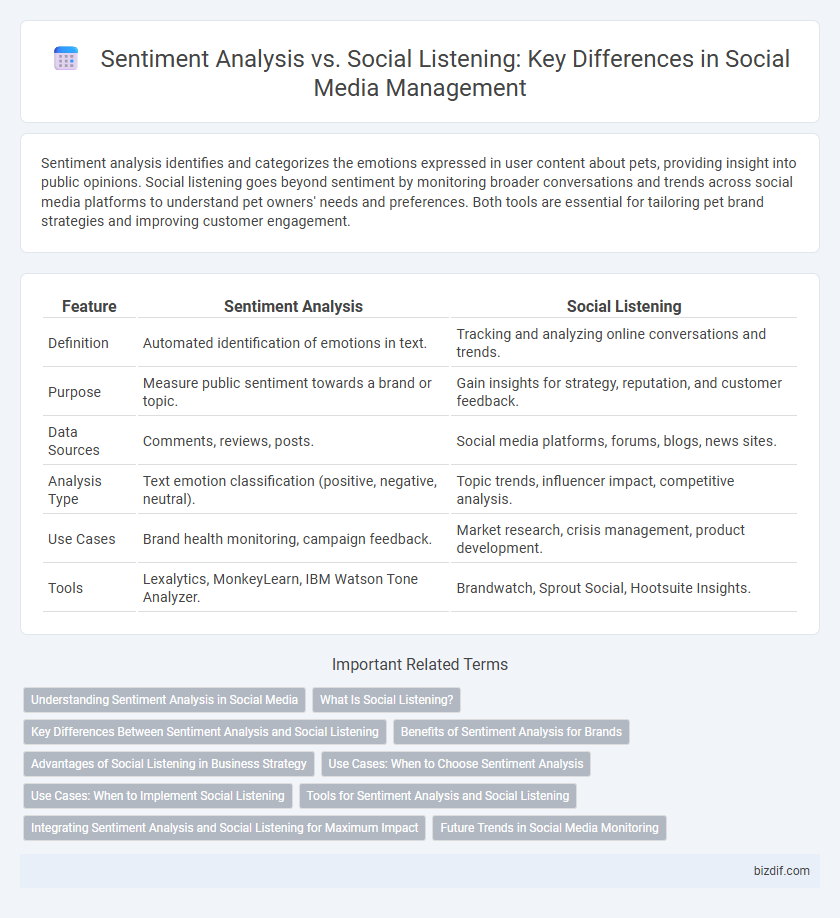Sentiment analysis identifies and categorizes the emotions expressed in user content about pets, providing insight into public opinions. Social listening goes beyond sentiment by monitoring broader conversations and trends across social media platforms to understand pet owners' needs and preferences. Both tools are essential for tailoring pet brand strategies and improving customer engagement.
Table of Comparison
| Feature | Sentiment Analysis | Social Listening |
|---|---|---|
| Definition | Automated identification of emotions in text. | Tracking and analyzing online conversations and trends. |
| Purpose | Measure public sentiment towards a brand or topic. | Gain insights for strategy, reputation, and customer feedback. |
| Data Sources | Comments, reviews, posts. | Social media platforms, forums, blogs, news sites. |
| Analysis Type | Text emotion classification (positive, negative, neutral). | Topic trends, influencer impact, competitive analysis. |
| Use Cases | Brand health monitoring, campaign feedback. | Market research, crisis management, product development. |
| Tools | Lexalytics, MonkeyLearn, IBM Watson Tone Analyzer. | Brandwatch, Sprout Social, Hootsuite Insights. |
Understanding Sentiment Analysis in Social Media
Sentiment analysis in social media uses natural language processing and machine learning to classify and quantify emotions in user-generated content. It enables brands to gauge public opinion, identify customer pain points, and measure campaign effectiveness by analyzing positive, negative, or neutral sentiments across posts and comments. Accurate sentiment analysis drives data-informed decisions and enhances customer relationship management by detecting trends and emerging issues in real time.
What Is Social Listening?
Social listening is the process of monitoring and analyzing online conversations and mentions across social media platforms to understand public sentiment, track brand reputation, and identify emerging trends. Unlike sentiment analysis, which focuses on evaluating emotions within specific content, social listening provides a broader, real-time overview of audience behaviors and preferences by aggregating data from multiple sources. This strategic approach helps businesses make informed decisions, improve customer engagement, and respond proactively to market changes.
Key Differences Between Sentiment Analysis and Social Listening
Sentiment analysis focuses on detecting and categorizing emotions expressed in social media content, using algorithms to identify positive, negative, or neutral tones. Social listening involves monitoring broader online conversations to understand trends, audience preferences, and brand perception in real time. Key differences include sentiment analysis's role in emotion detection versus social listening's emphasis on comprehensive market insights and proactive engagement strategies.
Benefits of Sentiment Analysis for Brands
Sentiment analysis enables brands to quantify and interpret customer emotions across social media platforms, providing actionable insights to enhance marketing strategies and customer engagement. By automatically categorizing positive, negative, or neutral feedback, companies can quickly respond to issues and improve brand reputation management. Real-time sentiment data helps optimize campaigns, tailor messaging, and monitor public perception, leading to stronger brand loyalty and increased ROI.
Advantages of Social Listening in Business Strategy
Social listening provides businesses with real-time insights into customer opinions, allowing for proactive reputation management and strategic decision-making. By analyzing broader conversations across multiple platforms, companies can identify emerging trends and pain points that sentiment analysis alone might miss. This comprehensive understanding of the market enhances customer engagement, product development, and competitive advantage.
Use Cases: When to Choose Sentiment Analysis
Sentiment analysis is ideal for measuring customer opinions during product launches, marketing campaigns, or crisis management to gauge emotional responses at scale. It enables brands to quantify positive, negative, or neutral attitudes from large volumes of social media data, facilitating real-time decision-making. Use sentiment analysis when precise emotional metrics and trend detection are critical for adjusting brand strategies or customer engagement tactics.
Use Cases: When to Implement Social Listening
Social listening excels in identifying emerging trends and monitoring brand reputation by analyzing broader online conversations across platforms. Use social listening when your goal is to understand customer sentiment at a macro level, detect potential crises early, and gain insights into market shifts. Sentiment analysis, while useful for gauging emotions in specific content, is best suited for detailed customer feedback rather than ongoing brand surveillance.
Tools for Sentiment Analysis and Social Listening
Tools for sentiment analysis, such as Brandwatch, Lexalytics, and MonkeyLearn, utilize natural language processing algorithms to classify social media content by emotions or opinions. Social listening platforms like Hootsuite Insights, Sprout Social, and Talkwalker aggregate real-time data across multiple channels, enabling brands to track conversations and emerging trends. Combining these tools enhances the ability to analyze consumer sentiment at scale while monitoring brand reputation and competitive insights.
Integrating Sentiment Analysis and Social Listening for Maximum Impact
Integrating sentiment analysis with social listening enhances the accuracy and depth of consumer insights by combining emotional tone detection with real-time brand monitoring across social platforms. This synergy allows businesses to identify emerging trends, respond proactively to customer feedback, and tailor marketing strategies to specific audience sentiments. Leveraging advanced AI-driven tools for both sentiment analysis and social listening maximizes engagement, optimizes reputation management, and drives data-informed decision-making.
Future Trends in Social Media Monitoring
Sentiment analysis and social listening are evolving with advancements in AI to predict consumer emotions and emerging trends more accurately. Future trends in social media monitoring emphasize real-time data integration, multilingual analysis, and enhanced context understanding through natural language processing. Businesses leveraging these innovations can gain deeper insights into brand perception and customer behavior, driving more strategic decision-making.
Sentiment analysis vs Social listening Infographic

 bizdif.com
bizdif.com